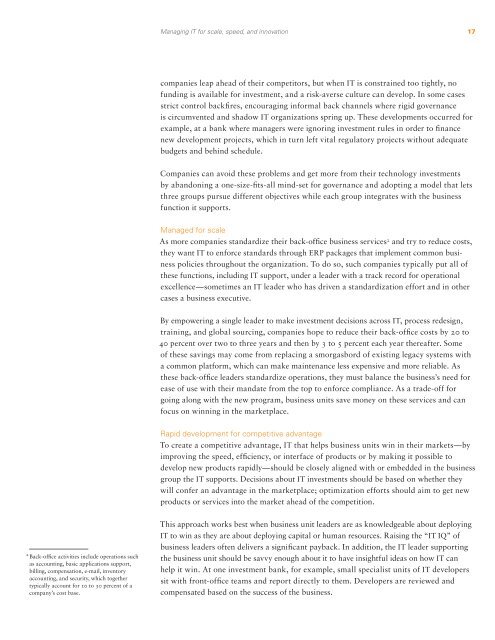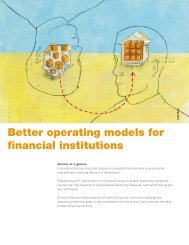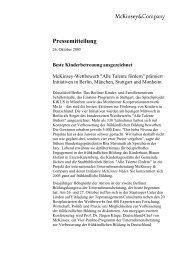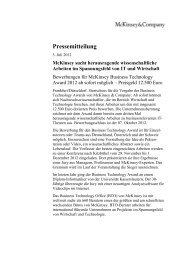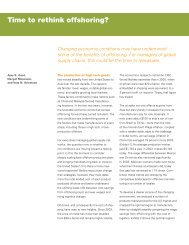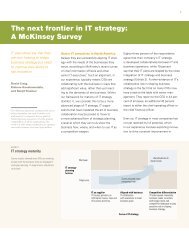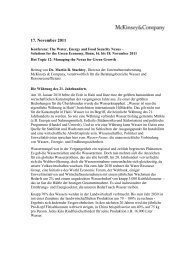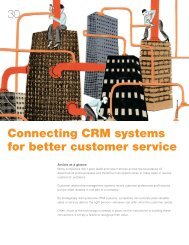Managing IT for scale, speed, and innovation - McKinsey & Company
Managing IT for scale, speed, and innovation - McKinsey & Company
Managing IT for scale, speed, and innovation - McKinsey & Company
You also want an ePaper? Increase the reach of your titles
YUMPU automatically turns print PDFs into web optimized ePapers that Google loves.
2 Back-office activities include operations such<br />
as accounting, basic applications support,<br />
billing, compensation, e-mail, inventory<br />
accounting, <strong>and</strong> security, which together<br />
typically account <strong>for</strong> 10 to 30 percent of a<br />
company’s cost base.<br />
<strong>Managing</strong> <strong>IT</strong> <strong>for</strong> <strong>scale</strong>, <strong>speed</strong>, <strong>and</strong> <strong>innovation</strong><br />
companies leap ahead of their competitors, but when <strong>IT</strong> is constrained too tightly, no<br />
funding is available <strong>for</strong> investment, <strong>and</strong> a risk-averse culture can develop. In some cases<br />
strict control backfires, encouraging in<strong>for</strong>mal back channels where rigid governance<br />
is circumvented <strong>and</strong> shadow <strong>IT</strong> organizations spring up. These developments occurred <strong>for</strong><br />
example, at a bank where managers were ignoring investment rules in order to finance<br />
new development projects, which in turn left vital regulatory projects without adequate<br />
budgets <strong>and</strong> behind schedule.<br />
Companies can avoid these problems <strong>and</strong> get more from their technology investments<br />
by ab<strong>and</strong>oning a one-size-fits-all mind-set <strong>for</strong> governance <strong>and</strong> adopting a model that lets<br />
three groups pursue different objectives while each group integrates with the business<br />
function it supports.<br />
Managed <strong>for</strong> <strong>scale</strong><br />
As more companies st<strong>and</strong>ardize their back-office business services 2 <strong>and</strong> try to reduce costs,<br />
they want <strong>IT</strong> to en<strong>for</strong>ce st<strong>and</strong>ards through ERP packages that implement common busi-<br />
ness policies throughout the organization. To do so, such companies typically put all of<br />
these functions, including <strong>IT</strong> support, under a leader with a track record <strong>for</strong> operational<br />
excellence—sometimes an <strong>IT</strong> leader who has driven a st<strong>and</strong>ardization ef<strong>for</strong>t <strong>and</strong> in other<br />
cases a business executive.<br />
By empowering a single leader to make investment decisions across <strong>IT</strong>, process redesign,<br />
training, <strong>and</strong> global sourcing, companies hope to reduce their back-office costs by 20 to<br />
40 percent over two to three years <strong>and</strong> then by 3 to 5 percent each year thereafter. Some<br />
of these savings may come from replacing a smorgasbord of existing legacy systems with<br />
a common plat<strong>for</strong>m, which can make maintenance less expensive <strong>and</strong> more reliable. As<br />
these back-office leaders st<strong>and</strong>ardize operations, they must balance the business’s need <strong>for</strong><br />
ease of use with their m<strong>and</strong>ate from the top to en<strong>for</strong>ce compliance. As a trade-off <strong>for</strong><br />
going along with the new program, business units save money on these services <strong>and</strong> can<br />
focus on winning in the marketplace.<br />
Rapid development <strong>for</strong> competitive advantage<br />
To create a competitive advantage, <strong>IT</strong> that helps business units win in their markets—by<br />
improving the <strong>speed</strong>, efficiency, or interface of products or by making it possible to<br />
develop new products rapidly—should be closely aligned with or embedded in the business<br />
group the <strong>IT</strong> supports. Decisions about <strong>IT</strong> investments should be based on whether they<br />
will confer an advantage in the marketplace; optimization ef<strong>for</strong>ts should aim to get new<br />
products or services into the market ahead of the competition.<br />
This approach works best when business unit leaders are as knowledgeable about deploying<br />
<strong>IT</strong> to win as they are about deploying capital or human resources. Raising the “<strong>IT</strong> IQ” of<br />
business leaders often delivers a significant payback. In addition, the <strong>IT</strong> leader supporting<br />
the business unit should be savvy enough about it to have insightful ideas on how <strong>IT</strong> can<br />
help it win. At one investment bank, <strong>for</strong> example, small specialist units of <strong>IT</strong> developers<br />
sit with front-office teams <strong>and</strong> report directly to them. Developers are reviewed <strong>and</strong><br />
compensated based on the success of the business.


